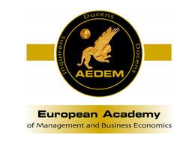Cultural dynamics and business strategies in international markets
DOI:
https://doi.org/10.35564/jmbe.2025.0019Keywords:
Business Education, Intercultural Competence, Cultural Intelligence, Teaching Global Strategy, International Business Curriculum, Global LearningAbstract
Through an analysis of cultural dynamics and global markets, this study probes the interplay of cultural and global influences on business strategy in the context of international expansion. Data are collected from 217 respondents through structured questionnaires that are distributed via Qualtrics, and the research uses Partial Least Squares Structural Equation Modeling (PLS-SEM) to analyze this data. The findings indicate a negative effect of perceived cultural barriers on business performance (β = -0.229), through cross-cultural communication (β = -0.249), indicating a need for a culturally adaptive communication strategy. On the one hand, the impact of cultural intelligence on market adaptability is significant (β = 0.618), but its direct effect on business performance is not significant, suggesting that market adaptability should be combined with other strategic efforts. the study also shows that cultural diversity enhances creativity without directly yielding competitive advantage as shown by its weak impact on purchase intention (β = -0.042). Finally, the study concludes that those businesses that embed cultural complexities and successfully manage them tend to have better results in the global market. It also points out that business schools should pay more attention to cultural intelligence. It gives real-world advice for developing course materials, preparing globally skilled experts, and helping business leaders adjust to cultural differences on a global scale.
Downloads
References
Akram, M. S., Malhotra, N., Goraya, M. A. S., Shareef, M. A., Malik, A., & Lal, B. (2022). User engagement on global social networks: Examining the roles of perceived brand globalness, identification and global identity. Technological Forecasting and Social Change, 181(121771), 121771. https://doi.org/10.1016/j.techfore.2022.121771
Alfawaire, F., & Atan, T. (2021). The effect of strategic human resource and knowledge management on sustainable competitive advantages at Jordanian Universities: The mediating role of organizational innovation. Sustainability, 13(15), 8445. https://doi.org/10.3390/su13158445
Appel, G., Grewal, L., Hadi, R., & Stephen, A. T. (2020). The future of social media in marketing. Journal of the Academy of Marketing Science, 48(1), 79–95. https://doi.org/10.1007/s11747-019-00695-1
Azeem, M., Ahmed, M., Haider, S., & Sajjad, M. (2021). Expanding competitive advantage through organizational culture, knowledge sharing and organizational innovation. Technology in Society, 66(101635), 101635. https://doi.org/10.1016/j.techsoc.2021.101635
Bhattacharya, S., Gaurav, K., & Ghosh, S. (2019). Viral marketing on social networks: An epidemiological perspective. Physica A, 525, 478–490. https://doi.org/10.1016/j.physa.2019.03.008
Blanco-González, A., Saavedra García, M. L., Cachón-Rodríguez, G., & García Nistal, A. (2024). Research in business education. Connecting research with the educational challenges of universities. Journal of Management and Business Education, 7(3), 379–395. https://doi.org/10.35564/jmbe.2024.0021
Borreguero Arias, D., Gómez Martínez, R., Alard Josemaría, J., & Prado Román, C. (2024). La Inteligencia Artificial (IA) como herramienta de predicción de la cultura financiera de un país. Journal of Management and Business Education, 7(3), 477–491. https://doi.org/10.35564/jmbe.2024.0027
Bouncken, R., Brem, A., & Kraus, S. (2016). Multi-cultural teams as sources for creativity and innovation: The role of cultural diversity on team performance. International Journal of Innovation Management, 20(01), 1650012. https://doi.org/10.1142/s1363919616500122
Cabanelas, P., Mora Cortez, R., Pérez-Moure, H., & Lampón, J. F. (2025). Sampling and sample size in B2B marketing: Current practices and recommendations. Industrial Marketing Management, 125, 71–86. https://doi.org/10.1016/j.indmarman.2024.12.014
Chabowski, B. R., Gabrielsson, P., Hult, G. T. M., & Morgeson, I. (2023). Sustainable international business model innovations for a globalizing circular economy: a review and synthesis, integrative framework, and opportunities for future research. Journal of International Business Studies, 2023, 1–20. https://doi.org/10.1057/s41267-023-00652-9
Chae, D., Kim, J., Kim, K., Ryu, J., Asami, K., & Doorenbos, A. Z. (2023). An immersive virtual reality simulation for cross-cultural communication skills: Development and feasibility. Clinical Simulation in Nursing, 77, 13–22. https://doi.org/10.1016/j.ecns.2023.01.005
Cherunilam, F. (2020). International business. PHI Learning Pvt. Ltd.
Daraojimba, C., Abioye, K. M., Bakare, A. D., Mhlongo, N. Z., Onunka, O., & Daraojimba, D. O. (2023). Technology and innovation to growth of entrepreneurship and Financial Boost: A decade in review (2013-2023). International Journal of Management & Entrepreneurship Research, 5(10), 769–792. https://doi.org/10.51594/ijmer.v5i10.593
Earley, P. C., Ang, S., & Tan, J. S. (2006). CQ: Developing cultural intelligence at work. Stanford University Press. https://doi.org/10.1515/9781503619715
Ferdowsi, J. (2024). Navigating HR in a Globalized Business Environment: Analyzing the Complexities of Managing HR Functions Across Borders, Including Cross-Cultural Management, International Labor Laws, and Strategies for Success in Globalized Enterprises. In Globalized Business Environment: Analyzing the Complexities of Managing HR Functions Across Borders, Including Cross-Cultural Management, International Labor Laws, and Strategies for Success in Globalized Enterprises. https://doi.org/10.2139/ssrn.5098565
Gallego-Álvarez, I., & Pucheta-Martínez, M. C. (2021). Hofstede’s cultural dimensions and R&D intensity as an innovation strategy: a view from different institutional contexts. Eurasian Economic Review, 11(2), 191–220. https://doi.org/10.1007/s40821-020-00168-4
Garg, G. (2023). Innovators unleashed: strategies for industry domination. Gaurav Garg.
Ginzarly, M., Houbart, C., & Teller, J. (2019). The Historic Urban Landscape approach to urban management: a systematic review. International Journal of Heritage Studies, 25(10), 999–1019. https://doi.org/10.1080/13527258.2018.1552615
He, W., Boateng, A., & Ring, P. (2019). Motives, choice of entry mode, and challenges of bank internationalization: Evidence from China. Thunderbird International Business Review, 61(6), 897–909. https://doi.org/10.1002/tie.22062
Headley, M. L. (2021). The role of motivational, cognitive, metacognitive, and behavioral cultural intelligence strategies in improving business communications of multinational corporate leaders: A systematic review of the literature (Doctoral dissertation).
Hennart, J.-F., & Sutherland, D. (2022). International business research: The real challenges are data and theory. Journal of International Business Studies, 53(9), 2068–2087. https://doi.org/10.1057/s41267-022-00566-y
Hilmersson, M., Johanson, M., Papaioannou, S., & Lundberg, H. (2022). Business unpredictability, improvisation and business network commitment in small and medium-sized enterprise market entry. International Small Business Journal, 40(8), 991–1018. https://doi.org/10.1177/02662426211069964
Hofstede, G., & Bond, M. H. (1984). Hofstede’s culture dimensions: An independent validation using Rokeach’s value survey. Journal of Cross-Cultural Psychology, 15(4), 417–433. https://doi.org/10.1177/0022002184015004003
Homer, S. T., & Lim, W. M. (2024). Theory development in a globalized world: Bridging “Doing as the Romans Do” with “Understanding Why the Romans Do It.” Global Business and Organizational Excellence, 43(3), 127–138. https://doi.org/10.1002/joe.22234
Huang, H. (2023). Research on the Importance of Cross-cultural Integration in International Business Management. Modern Economics & Management Forum.
Huang, S. (sam), & Crotts, J. (2019). Relationships between Hofstede’s cultural dimensions and tourist satisfaction: A cross-country cross-sample examination. Tourism Management, 72, 232–241. https://doi.org/10.1016/j.tourman.2018.12.001
Hult, G. T. M., Morgeson, F. V., III, Sharma, U., & Fornell, C. (2022). Customer satisfaction and international business: A multidisciplinary review and avenues for research. Journal of International Business Studies, 53(8), 1695–1733. https://doi.org/10.1057/s41267-022-00546-2
Inderjeet, O. S., & Choudhary, M. (2023). Navigating Changing Consumer Behavior And Maggi’s Marketing Strategies In The Indian Market. Journal of Namibian Studies: History Politics Culture, 39, 640–656.
Jeyaraj, A., & Sethi, V. (2025). Generative ai tools in software teaching and learning: implications for business education. Journal of Management and Business Education, 8(1), 127–146. https://doi.org/10.35564/jmbe.2025.0008
Jones, G., Chirino Chace, B., & Wright, J. (2020). Cultural diversity drives innovation: empowering teams for success. International Journal of Innovation Science, 12(3), 323–343. https://doi.org/10.1108/ijis-04-2020-0042
Katsikeas, C., Leonidou, L., & Zeriti, A. (2020). Revisiting international marketing strategy in a digital era: Opportunities, challenges, and research directions. International Marketing Review, 37(3), 405–424. https://doi.org/10.1108/imr-02-2019-0080
Khlif, H. (2016). Hofstede’s cultural dimensions in accounting research: a review. Meditari Accountancy Research, 24(4), 545–573. https://doi.org/10.1108/medar-02-2016-0041
Kotabe, M. M., & Helsen, K. (2022). Global marketing management. John Wiley & Sons.
Krejcie, R. V., & Morgan, D. W. (1970). Determining sample size for research activities. Educational and Psychological Measurement, 30(3), 607–610. https://doi.org/10.1177/001316447003000308
Lave, J. (2021). The culture of acquisition and the practice of understanding 1,” in Situated cognition. Routledge. 17–35.
Liu, J., Li, X., Zhang, L., Lu, Q., & Su, X. (2023). Authenticity, psychological ownership and tourist commitment in heritage tourism: the moderating effect of cultural intelligence. Current Issues in Tourism, 26(24), 3955–3972. https://doi.org/10.1080/13683500.2022.2153650
Masoud, R. I., Liu, Z., Ferianc, M., Treleaven, P., & Rodrigues, M. (2023). Cultural alignment in large language models: An explanatory analysis based on Hofstede’s cultural dimensions. In arXiv [cs.CY]. http://arxiv.org/abs/2309.12342
Meyer, K. E., Li, J., Brouthers, K. D., & Jean, R.-J. “‘bryan.’” (2023). International business in the digital age: Global strategies in a world of national institutions. Journal of International Business Studies, 54(4), 577–598. https://doi.org/10.1057/s41267-023-00618-x
Morrison-Smith, S., & Ruiz, J. (2020). Challenges and barriers in virtual teams: a literature review. SN Applied Sciences, 2(6). https://doi.org/10.1007/s42452-020-2801-5
Mukherjee, S., Das, M. K., & Chakraborty, T. K. (2023). Viral marketing in increasing brand awareness and predicting purchase intention: exploring mediating role of brand loyalty in FMCG sector. Sch J Econ Bus Manag, 4, 61–77. https://doi.org/10.36347/sjebm.2023.v10i04.001
Oguji, N., & Owusu, R. A. (2021). Market entry into Africa: Acquisitions and international joint ventures. Studies of foreign firms’ market entry strategies, challenges, and performance in Africa. Thunderbird International Business Review, 63(1), 5–9. https://doi.org/10.1002/tie.22170
Paiuc, D. (2021). Cultural intelligence as a core competence of inclusive leadership. Management Dynamics in the Knowledge Economy, 9(3), 363–378. https://doi.org/10.2478/mdke-2021-0024
Rana, G., & Sharma, R. (2019). Assessing impact of employer branding on job engagement: A study of banking sector. Emerging Economy Studies, 5(1), 7–21. https://doi.org/10.1177/2394901519825543
Rogers, A. (2020). Human behavior in the social environment: Perspectives on development, the life course, and macro contexts. https://doi.org/10.4324/9781003025382
Setti, I., Sommovigo, V., & Argentero, P. (2022). Enhancing expatriates’ assignments success: the relationships between cultural intelligence, cross-cultural adaptation and performance. Current Psychology (New Brunswick, N.J.), 41(7), 4291–4311. https://doi.org/10.1007/s12144-020-00931-w
Shadiev, R., Wang, X., & Huang, Y.-M. (2021). Cross-cultural learning in virtual reality environment: facilitating cross-cultural understanding, trait emotional intelligence, and sense of presence. Educational Technology Research and Development: ETR & D, 69(5), 2917–2936. https://doi.org/10.1007/s11423-021-10044-1
Shalini, D. T. (2023). Pragmatic Cross - Cultural Communication in the International Business Arena. Literature Review. International Journal of Science and Research. https://doi.org/10.21275/sr231122095829
Sharma, G. D., Kraus, S., Talan, A., Srivastava, M., & Theodoraki, C. (2024). Navigating the storm: the SME way of tackling the pandemic crisis. Small Business Economics, 63(1), 221–241. https://doi.org/10.1007/s11187-023-00810-1
Steenkamp, J.-B. E. M. (2019). The uncertain future of globalization: Implications for global consumer cultures and global brands. International Marketing Review, 36(4), 524–535. https://doi.org/10.1108/imr-12-2018-0355
Steers, R. M., Osland, J. S., & Szkudlarek, B. (2023). Management across cultures: Challenges, strategies, and skills. Cambridge University Press. https://doi.org/10.1017/9781009359290
Su, S. (2023). International Business Strategies of Firms with Political Changes: A Case of Xiaomi’s Entry into the Indian Market. BCP Business & Management. https://doi.org/10.54691/bcpbm.v40i.4383
Tripathi, R. (2024). Identity and Nation in Coca Cola’s Thanda Narratives in India: A Semiotic Study. Journal of Narrative and Language Studies, 12(24), 71–84. https://doi.org/10.59045/nalans.2024.43
Wang, R., & Liu, S. (2022). Research on Training Methods of Cross-cultural Writing Ability of Application-oriented International Business Talents. Frontiers in Educational Research, 5(8). https://doi.org/10.25236/fer.2022.050804
Witt, M. A., Lewin, A. Y., Li, P. P., & Gaur, A. (2023). Decoupling in international business: Evidence, drivers, impact, and implications for IB research. Journal of World Business, 58(1), 101399. https://doi.org/10.1016/j.jwb.2022.101399
Xia, Y., Shin, S.-Y., & Kim, J.-C. (2024). Cross-Cultural Intelligent Language Learning System (CILS): Leveraging AI to facilitate language learning strategies in cross-cultural communication. Applied Sciences (Basel, Switzerland), 14(13), 5651. https://doi.org/10.3390/app14135651
Yang, M., & Leppäaho, T. (2023). Network bricolage of international entrepreneurs for new market entry: a cross-national study of small biotech firms. International Marketing Review, 40(7), 22–44. https://doi.org/10.1108/imr-05-2022-0133

Downloads
Published
How to Cite
Issue
Section
License
Copyright (c) 2025 Journal of Management and Business Education

This work is licensed under a Creative Commons Attribution-NonCommercial-ShareAlike 4.0 International License.
License terms at: https://creativecommons.org/licenses/by-nc/4.0/legalcode



